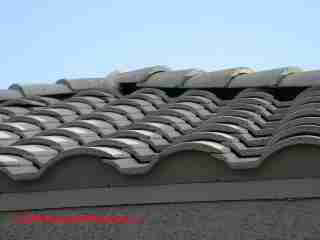 Clay Tile Roof Installation
Clay Tile Roof Installation
Eaves, Ridge, Hip, Rake Closure
- POST a QUESTION or COMMENT about how clay tile roof openings are enclosed or sealed at eaves, ridge, hips, etc.
Clay roofing tile hip, ridge & rake installation & closure details:
This article describes the special connection methods used seal or close the ridge, hip, and rake sections of clay tile roofs.
This article series explains clay tile roofing types, clay roofing tile inspection, tile roofing diagnosis, & tile roof repair.
InspectAPedia tolerates no conflicts of interest. We have no relationship with advertisers, products, or services discussed at this website.
- Daniel Friedman, Publisher/Editor/Author - See WHO ARE WE?
Eaves, Hip, & Rake Installation Details for Tile Roofs

This article series discusses best practices in the selection and installation of residential roofing. Also see our home page for clay tile roofing, starting at CLAY TILE ROOFING. Adapted/paraphrased with permission from Best Practices Guide to Residential Construction (Steve Bliss, J Wiley & Sons) , chapter on BEST ROOFING PRACTICES:
A number of specialized flashings, tiles, and fittings simplify modern roofing tile installations.
At left our photo shows special ridge tiles on a home in New York state, including one broken tile that needs replacement. In this location leakage was minimal.
Key details for interlocking flat and profile roofing tiles are shown in Figure 2-26
and Figure 2-27 just below, illustrating both curved (below left) and flat (below right) clay (or concrete) roof tile installation fittings that help seal against the weather.
Click any image to see an enlarged, detailed vesion.
[Click to enlarge any image]
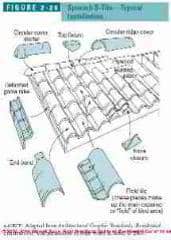
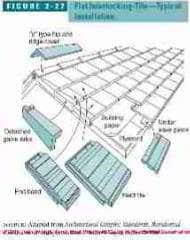
Eaves Closure Requirements on Tile Roofs
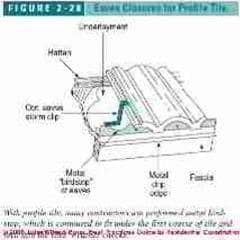
Both profile and flat clay roof tiles need special treatment at the eaves to raise the bottom edge of the first tile to the correct height and to close off any openings to birds and insects.
For profile tiles, many tile roofing contractors use a metal birdstop, a preformed L-shaped strip with the vertical leg cut to match the underside of the first tile and fit snugly between the weather checks (see Figure 2-28 at left).
With some high-profile clay or concrete roofing tiles, a special eaves-closure tile achieves the same effect as shown in Figure 2-26 above. [Click any of our images or tables to see an enlarged view.]
With flat clay roofing tiles, the first course may be raised with a special starter tile, as shown at left in Figure 2-27, or by a metal eaves closure, raised fascia, or wood cant strip.
With a cant strip or raised fascia, a beveled wood or foam antiponding strip is required to prevent ponding of water along the eaves (Figure 2-29 below).

Ridge and Hip Requirements on Tile Roofs
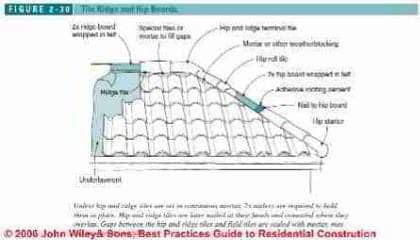
Unless hip and ridge tiles on a clay tile roof are going to be set into a continuous bed of mortar, special nailers are required to install them.
The hip and ridge boards are typically 2x3s to 2x6s set on edge to hold the trim tiles in an even plane.
They are toenailed in place and individually wrapped with felt (Figure 2-30 shown at left).
Hip and ridge tiles are later nailed on with a 2-inch head-lap, and the lower ends are sealed at the overlap with roofing cement or an approved tile adhesive.
Finally, mortar, special trim tiles, or other weatherblocking is applied to fill in gaps between the ridge and hip tiles and the field tile.
Rake Requirements on Tile Roofs
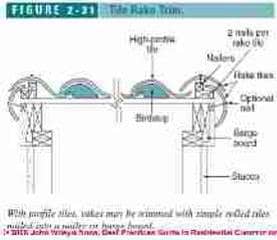
Rakes on clay tile roofs may be finished with detached gable-rake tiles (as shown in Figures 2-26
and Figure 2-27 shown just above, or with highprofile tiles, trimmed simply with half-round trim tiles
as shown in Figure 2-31 shown at left.
- - Adapted with permission from Best Practices Guide to Residential Construction (Steve Bliss, J Wiley & Sons) .
-- Adapted with permission from Best Practices Guide to Residential Construction (Steve Bliss, J Wiley & Sons) .
...
Reader Comments, Questions & Answers About The Article Above
Below you will find questions and answers previously posted on this page at its page bottom reader comment box.
Reader Q&A - also see RECOMMENDED ARTICLES & FAQs
On 2020-09-11 by (mod) - bird stop missing from clay tile roof
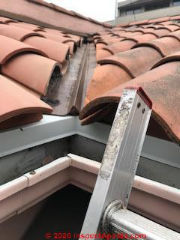 In your photo, no, there are no bird stops or screens that I can see.
In your photo, no, there are no bird stops or screens that I can see.
On 2020-09-11 by Carl
Are Clay Tile valley's enclosed with bird stoppers or not?
On 2020-08-31 by (mod) - rats and squirrels are getting into my clay tile roof
William: yes that's perfectly reasonable.
On 2020-08-27 by william a kimbrough
At the bottom of the roof, where the bird stop is, it seems that some holes were cut during installation, maybe to allow water out. However, it seems that rats, squirrels get in..
Is it permissible to cover the holes with hardware cloth from the outside to exclude vermin? The picture is self explanatory....
In the event that the "bird stop" at the bottom of the tile roof has a hole cut into it to allow water from above to run out, it appears that rats, squirrels, etc. are getting into the house.
Is is permissible to put hardware cloth across the holes to exclude vermin ? Is it best to screw the hardware cloth on the outside? 1/4" mesh?
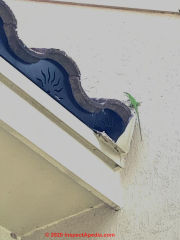
On 2020-04-07 by (mod) - you can add the end and closures under your Tiles at the roof Eaves
Yes you certainly can add the end and closures under your Tiles at the roof Eaves after the tiles have been installed. Unfortunately there is going to be a bit more labor and effort involved than would have been had that closure been installed at the time of original roof installation.
And maybe some cutting and pasting involved.
Common step is to use concrete to close those openings or pre-fab inserts that permit venting, but all events be sure that an appropriate drain opening is still provided.
Otherwise you could trap water against the roof deck.
On 2020-04-07 by Gray
We have a tile roof and when the roof was installed, the builder did not install the end enclosures. Can they be added now that the roof is finished?
On 2020-03-18 - by (mod) -
Mary
Beyond the aesthetic disappointment ( a common one )
everything depends on the materials used and quality of installation of tile roof valley liner or covering.
It is that liner that will prevent (or not) leaks at the roof valley on this installation.
On 2020-03-18 by Marty
Is this problematic or is it just aesthetic?? It there any trim to improve the appearance?
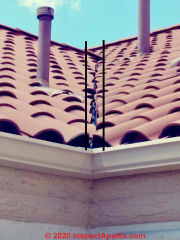
On 2020-03-18 by Marty
Is this problematic or is it just aesthetic?
It there any trim to improve the appearance?

Is there any trim that can be used to hide bad angle cuts??
On 2020-01-25 by (mod) -
Of course, Ken I absolutely believe it.
On 2020-01-25 by Ken
Ken Said
I found the YouTube video for the vent installation. <link bad at our loc> It shows the stiff plastic pieces installed against TRV-4 ridge. Don't know the P/N.
The ridge vent is NOT the installation that I have on the roof. The roof has individual mesh vents and the ridge board does not cut into the roof top. As you can see the hard plastic pieces fit onto the bottom of S tiles.
Because they are stiff, there are also left and right pieces to fit the angle hip
. If the pieces don't fit to the bottom of S tiles, wind driven rain will get underneath. The flexible alternative would be ideal.
I actually observed the side blowing rain because the house sits on the hill with strong uplifting. The roofer did not believe that could cause damage, but actually did.
On 2020-01-25 by (mod) -
Rain blowing in and occasionally in some climates fine snow blowing into attics is a complaint we've gotten from time to time;
Some experts opine that the total water volume entering the building is trivial. I figure in severe weather (and of course as the climate changes ever more rapidly we're seeing more of that) windblown rain is going to be an increasing concern.
Some ridge and hip vent systems anticipate that with taller rain-baffles running along the vent body;
Others rely on a very low-profile plastic-mesh filled vent system that in my OPINON doesn't move much air - at least not nearly as much as an open type vent.
On 2020-01-25 by Ken
Thanks for pointing to the right direction (that is: hip and ridge vent). The ridge board of the house is about 6" - exposing to wind-blown winter rainstorms. I'll study a bit closer and report back.
On 2020-01-24 by (mod) - ridge & hip vents for clay tile roofs
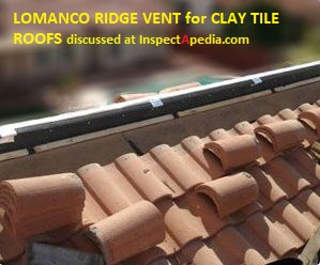 Ken I'm not exactly sure what part for tile roofs you seek but it sounds like a hip and ridge vent; there are a number of companies making clay tile roof vents, such as Lomanco
Ken I'm not exactly sure what part for tile roofs you seek but it sounds like a hip and ridge vent; there are a number of companies making clay tile roof vents, such as Lomanco
https://www.lomanco.com/tileridge-trv4
shown here
Choosing a ridge or hip vent that has a wind baffle will help against California wind-blown winter rainstorms.
Another detail to check: on tile roofs installers whose work I've seen do not carry hip venting all the way down the hip but rather confine it to roughly the upper half of the hip. Vents low on the hip tend to be leaky.
On 2020-01-24 by Ken
I cannot find a P/N for the hip-and-ridge plastic piece. My house is 25 years old. I am looking an alternative. I saw flexible ones like roofing tar paper.
But these hip-and-ridge plastic should have the lifespan of the clay tiles. PS. I am not posting an ad. Just solving my problem. There is high wind in the area which blows California winter rains sideways under the roof ridge tiles.
On 2020-01-23 by (mod) - Capisdtrano clay roof tile pattern
Ken
There are dozens of Capistrano pattern clay roofing tile manufacturers with whom you might check.
NOA 11-0321.03 Capistrano. 9 is a typical pattern name.
Here's one of the example photos from the company you cite (were you posting an ad for them?)
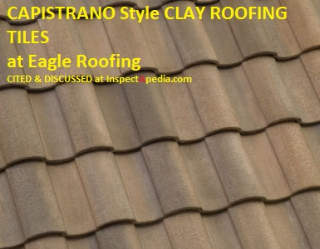
On 2020-01-23 by (mod) -
Re-posting without bad link
Ken said:
My house in California has Capistrano tiles made by Eagle roofing. The hip-and-ridge plastic pieces are about 3-ft long and curved to fit the bottom of S-tiles. They are stiff plastic and have "pat. 00-Lite L or R stamped on each piece.
The question is where to buy them, or the replacement with new design. See the picture in
On 2019-01-05 by (mod) -
Tina
In Florida many tile roofs are cosmetic-only - that is, the roof relies on an underlying absolutely reliable membrane on the roof surface, such as EPDM or modified bitumen.
IF that is the type of roof you have, it may be just fine - as long as the membrane itself was also properly installed.
Ask the roofer to confirm just what membrane is on the roof under the tiles.
On 2019-01-05 by Tina
I just got a new barrel tile roof on my house in south Florida. They left a couple areas empty without a tile in place. They told me this is to allow the water to drain. Is this normal? I’m concerned about something getting under the tiles from that opening.
On 2018-07-16 by Anonymous
@Chris,
I say flush, but if you are only trying to block birds of a certain size or larger, you'll have to make that determination.
On 2018-01-22 by Chris
Do I just start my bird stop flush to the Gable or set it back a few inches..?
Question: how much misalignment of roof tiles is OK?
(Aug 21, 2014) lagoberto said:
where can I buy eaves closures in kissimmee
(Apr 10, 2015) Piers Allbrook said:
Degree of 'misalignment' in tiles that is OK with a curved roof for instance Chinese/Japanese roof would appeciated
Reply:
nteresting question, Piers. I'm doubtful there's a single right answer since the risks of leaks or of breakage depend a lot on the specific tile shape and design. If we have a specific tile or manufacturer we could pursue it. If you want to send me some photos our email is at the page bottom CONTACT link - we may be able to comment further.
...
Continue reading at CLAY TILE ROOF FLASHING or select a topic from the closely-related articles below, or see the complete ARTICLE INDEX.
Or see these
Clay Roofing Tile Installation Articles
- CLAY TILE ROOFING - home
- CLAY TILE ROOF BATTENS & STACKING
- CLAY TILE ROOF CONNECTIONS
- CLAY TILE ROOF DAMAGE & WEAR
- CLAY TILE EAVES, HIP & RAKE DETAILS
- CLAY TILE ROOF FLASHING
- CLAY TILE ROOF FLASHING LEAKS
- CLAY TILE ROOF SLOPE, DECK & UNDERLAY
- CLAY TILE ROOF SPECIFICATIONS
- CLAY TILE ROOF SUPPLIERS
- CLAY TILE ROOF STYLES, DESIGNS
- CLAY TILE WIND & SEISMIC CONNECTORS
- CLAY, CONCRETE, FIBER CEMENT ROOF TILE CHOICES
- DURALITA & METAL TILE ROOFS
Suggested citation for this web page
CLAY TILE EAVES, HIP & RAKE DETAILS at InspectApedia.com - online encyclopedia of building & environmental inspection, testing, diagnosis, repair, & problem prevention advice.
Or see this
INDEX to RELATED ARTICLES: ARTICLE INDEX to BUILDING ROOFING
Or use the SEARCH BOX found below to Ask a Question or Search InspectApedia
Ask a Question or Search InspectApedia
Try the search box just below, or if you prefer, post a question or comment in the Comments box below and we will respond promptly.
Search the InspectApedia website
Note: appearance of your Comment below may be delayed: if your comment contains an image, photograph, web link, or text that looks to the software as if it might be a web link, your posting will appear after it has been approved by a moderator. Apologies for the delay.
Only one image can be added per comment but you can post as many comments, and therefore images, as you like.
You will not receive a notification when a response to your question has been posted.
Please bookmark this page to make it easy for you to check back for our response.
IF above you see "Comment Form is loading comments..." then COMMENT BOX - countable.ca / bawkbox.com IS NOT WORKING.
In any case you are welcome to send an email directly to us at InspectApedia.com at editor@inspectApedia.com
We'll reply to you directly. Please help us help you by noting, in your email, the URL of the InspectApedia page where you wanted to comment.
Citations & References
In addition to any citations in the article above, a full list is available on request.
- ARMA - Asphalt Roofing Manufacturer's Association - Asphalt Roofing Manufacturer's Association - https://www.asphaltroofing.org/
750 National Press Building, 529 14th Street, NW, Washington, DC 20045, Tel: 202 / 207-0917 - ASTM International, 100 Barr Harbor Drive, PO Box C700, West Conshohocken, PA, 19428-2959 USA The ASTM standards listed below can be purchased in fulltext directly from http://www.astm.org/
- NRCA - National Roofing Contractors Association - Website: www.nrca.net 10255 W. Higgins Road, Suite 600, Rosemont, IL 60018-5607, Tel: (847) 299-9070 Fax: (847) 299-1183
- UL - Underwriters Laboratories - https://www.ul.com/
2600 N.W. Lake Rd.
Camas, WA 98607-8542
Tel: 1.877.854.3577 / Fax: 1.360.817.6278 E-mail: cec.us@us.ul.com - Our recommended books about building & mechanical systems design, inspection, problem diagnosis, and repair, and about indoor environment and IAQ testing, diagnosis, and cleanup are at the InspectAPedia Bookstore. Also see our Book Reviews - InspectAPedia.
- Best Practices Guide to Residential Construction, by Steven Bliss. John Wiley & Sons, 2006. ISBN-10: 0471648361, ISBN-13: 978-0471648369, Hardcover: 320 pages, available from Amazon.com and also Wiley.com. See our book review of this publication.
- Decks and Porches, the JLC Guide to, Best Practices for Outdoor Spaces, Steve Bliss (Editor), The Journal of Light Construction, Williston VT, 2010 ISBN 10: 1-928580-42-4, ISBN 13: 978-1-928580-42-3, available from Amazon.com
- Problems in Roofing Design, B. Harrison McCampbell, Butterworth Heineman, 1991 ISBN 0-7506-9162-X (available used)
- Roofing The Right Way, Steven Bolt, McGraw-Hill Professional; 3rd Ed (1996), ISBN-10: 0070066507, ISBN-13: 978-0070066502
- Slate Roofs, National Slate Association, 1926, reprinted 1977 by Vermont Structural Slate Co., Inc., Fair Haven, VT 05743, 802-265-4933/34. (We recommend this book if you can find it. It has gone in and out of print on occasion.)
- Roof Tiling & Slating, a Practical Guide, Kevin Taylor, Crowood Press (2008), ISBN 978-1847970237,
If you have never fixed a roof tile or slate before but have wondered how to go about repairing or replacing them, then this is the book for you. Many of the technical books about roof tiling and slating are rather vague and conveniently ignore some of the trickier problems and how they can be resolved. In Roof Tiling and Slating, the author rejects this cautious approach. Kevin Taylor uses both his extensive knowledge of the trade and his ability to explain the subject in easily understandable terms, to demonstrate how to carry out the work safely to a high standard, using tried and tested methods.
This clay roof tile guide considers the various types of tiles, slates, and roofing materials on the market as well as their uses, how to estimate the required quantities, and where to buy them. It also discusses how to check and assess a roof and how to identify and rectify problems; describes how to efficiently "set out" roofs from small, simple jobs to larger and more complicated projects, thus making the work quicker, simpler, and neater; examines the correct and the incorrect ways of installing background materials such as underlay, battens, and valley liners; explains how to install interlocking tiles, plain tiles, and artificial and natural slates; covers both modern and traditional methods and skills, including cutting materials by hand without the assistance of power tools; and provides invaluable guidance on repairs and maintenance issues, and highlights common mistakes and how they can be avoided. The author, Kevin Taylor, works for the National Federation of Roofing Contractors as a technical manager presenting technical advice and providing education and training for young roofers. - The Slate Roof Bible, Joseph Jenkins, www.jenkinsslate.com, 143 Forest Lane, PO Box 607, Grove City, PA 16127 - 866-641-7141 (We recommend this book).
- Slate Roofing in Canada (Studi4es in archaeology, architecture, and history),
- Smart Guide: Roofing: Step-by-Step Projects, Creative Homeowner (Ed), 2004, ISBN-10: 1580111491, ISBN-13: 978-1580111492
- Solar heating, radiative cooling and thermal movement: Their effects on built-up roofing (United States. National Bureau of Standards. Technical note), William C Cullen, Superintendent of Documents, U.S. Govt. Print. Off (1963), ASIN: B0007FTV2Q
- Tile Roofs of Alfred: A Clay Tradition in Alfred NY
- In addition to citations & references found in this article, see the research citations given at the end of the related articles found at our suggested
CONTINUE READING or RECOMMENDED ARTICLES.
- Carson, Dunlop & Associates Ltd., 120 Carlton Street Suite 407, Toronto ON M5A 4K2. Tel: (416) 964-9415 1-800-268-7070 Email: info@carsondunlop.com. Alan Carson is a past president of ASHI, the American Society of Home Inspectors.
Thanks to Alan Carson and Bob Dunlop, for permission for InspectAPedia to use text excerpts from The HOME REFERENCE BOOK - the Encyclopedia of Homes and to use illustrations from The ILLUSTRATED HOME .
Carson Dunlop Associates provides extensive home inspection education and report writing material. In gratitude we provide links to tsome Carson Dunlop Associates products and services.

